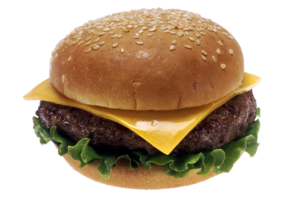Cheeseburger
 Cheeseburger | |
| Course | Main course |
|---|---|
| Place of origin | United States |
| Serving temperature | Hot |
| Main ingredients | Ground beef patty, Cheese, bread buns |
| 600-1500 kcal (-5680 kJ) | |
A cheeseburger is a hamburger topped with cheese. Traditionally, the slice of cheese is placed on top of the meat patty, but the burger can include many variations in structure, ingredients, and composition. The term itself is a portmanteau of the words "cheese" and "hamburger." The cheese is usually cubed, and then added to the cooking hamburger patty shortly before the patty is completely cooked which allows the cheese to melt. Cheeseburgers are often served with lettuce, tomato, onion, pickles, mustard, mayonnaise, or ketchup.
In fast food restaurants, the cheese used is typically processed cheese, but there are variations, such as cheddar, Swiss cheese, mozzarella, blue cheese and pepper jack. When cheese is added to a burger the nutritional value of the burger can be changed substantially. For example, a slice of Cheddar cheese can add 113[1] calories and 4.5 grams of saturated fat to a burger.[2] Other types and amounts of cheese would have varying effects, depending on their nutritional content.
History
Adding cheese to hamburgers became popular in the late-1920s to mid-1930s, and there are several competing claims as to who created the first cheeseburger. Lionel Sternberger is reputed to have invented the cheeseburger in 1926 at the age of 16 when he was working as a fry cook at his father's Pasadena, California sandwich shop, "The Rite Spot," and "experimentally dropped a slab of American cheese on a sizzling hamburger."[3][4][5][6][7]
An early example of the cheeseburger appearing on a menu is a 1928 menu for the Los Angeles restaurant O'Dell's which listed a cheeseburger smothered with chili for 25 cents.[8]
Other restaurants say they invented the cheeseburger. For example, Kaelin's Restaurant in Louisville, Kentucky, says it invented the cheeseburger in 1934.[9] One year later, a trademark for the name "cheeseburger" was awarded to Louis Ballast of the Humpty Dumpty Drive-In in Denver, Colorado.[10] According to Steak 'n Shake archives, the restaurant's founder, Gus Belt, applied for a trademark on the word in the 1930s.Cite error: A <ref> tag is missing the closing </ref> (see the help page).[11]
Religious and regional
Guatemala
Torito is the name of a popular cheeseburger variety in Guatemala. It consists primarily of a beef patty with mayonnaise, mustard, ketchup, processed cheese, fried egg, bacon, lettuce, tomato and commonly also ham. It is served in a bun, often with a side of French fries.
Israel
Traditionally, the cheeseburger is not kosher as it combines ground beef and cheese. Mixtures of milk and meat (Template:Lang-he, basar bechalav, literally "meat in milk") are prohibited according to Jewish law - Halakha (Template:Lang-he). This dietary law, basic to kashrut (Template:Lang-he), is based on a verse in the Book of Exodus which forbids "boiling a (kid) goat in its mother's milk".[12][13] This prohibition appears again in Deuteronomy.[14] This dietary law sparked controversy in Jerusalem when McDonald's began opening franchises there that sold cheeseburgers.[15] Since that time, McDonald's has opened both kosher and non-kosher restaurants in Israel.[16]
New York City
In an attempt to provide a "kosher cheeseburger", a kosher restaurant in New York City created a controversial cheeseburger variation which replaces cheese with soy cheese.[17]

See also
- Cheeseburger bill
- Cheeseburger in Paradise
- Jucy Lucy
- List of sandwiches
- List of hamburgers
- Patty melt
- Slider
- Ted's Restaurant
Famous specialty hamburgers that regularly come with cheese:
References
- ^ "Calorie count". Retrieved 11 November 2012.
- ^ "Nutrition Information for: Cheeseburger". FitDay.com. FitDay. Retrieved 2010-02-11.
- ^ "Lionel Clark Sternberg obituary". Time. 1964-02-07. Retrieved 2007-05-18.
…at the hungry age of 16, [Sternberger] experimentally dropped a slice of American cheese on a sizzling hamburger while helping out at his father's sandwich shop in Pasadena, thereby inventing the cheeseburger…
- ^ Harvey, Steve (1991-03-27). "Only in L.A.". L.A. Times. p. B2.
Cooking at his father's short-order joint in Pasadena in the early 1920s, [Sternberger] experimentally tossed a slice (variety unknown) on a hamburger...
- ^ Perry, Charles (2004-06-09). "It's an L.A. Thing; Our burgers are the best with good reason: We made them here first". L.A. Times. p. F1.
- ^ "Yes, it was invented in Pasadena! Probably. Tracing the cheeseburger from inception to Bob's Big Boy". Pasadena Sun. 2012-01-13. Retrieved 2012-05-13.
- ^ "The Tale of the Cheeseburger". San Gabriel Valley Tribune. 1999-06-23. Retrieved 2012-05-13.
- ^ "Old Menus Tell the History of Hamburgers in L.A." Metropolitan News-Enterprise. 2004-01-15. Retrieved 2012-05-13.
- ^ "Louisville Facts & Firsts - LouisvilleKy.gov". City of Louisville, Kentucky. Retrieved 2006-07-29.
- ^ History of the Cheeseburger Retrieved 2 October 2008
- ^ Hall, David (2006-10-24). "Society's fast food intake reeks". Daily Skiff. DailySkiff.com. Retrieved 2010-02-13.
- ^ Exodus 34:26
- ^ Exodus 23:19
- ^ Deuteronomy 14:21
- ^ Bronner, Ethan (1995-09-03). "Big Mac under attack in Jerusalem As McDonald's rings up sales of nonkosher burgers, outcry on 'cultural identity' heard". Boston Globe. bostonglobe.com. Retrieved 2010-08-21.
- ^ "Will residents of Jerusalem get to bite a kosher Big Mac?". J. the Jewish News Weekly of Northern California Magazine. jweekly.com. 2001-12-21. Retrieved 2010-08-21.
- ^ Montefinise, Angela (2008-03-02). "Jews Have A Beef". New York Post. nypost.com. Retrieved 2010-08-21.
External links
- Henerson, Evan (June 23, 1999). "The Tale of the Cheeseburger". San Gabriel Valley Tribune.

